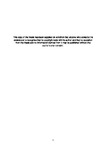The effect of dynamic mobilisation exercises on the equine multifidus muscle and thoracic profile
| dc.contributor.supervisor | Randle, Hayley | |
| dc.contributor.author | Tabor, Gillian | |
| dc.contributor.other | Faculty of Science and Engineering | en_US |
| dc.date.accessioned | 2015-04-21T14:55:58Z | |
| dc.date.available | 2015-04-21T14:55:58Z | |
| dc.date.issued | 2015 | |
| dc.identifier | 10366547 | en_US |
| dc.identifier.uri | http://hdl.handle.net/10026.1/3320 | |
| dc.description.abstract |
Introduction: A relationship between spinal musculature and back pathology has been established in human and equine studies. Exercises to increase Multifidus cross sectional area (CSA) have been shown to reduce the amount and reoccurrence of back pain in humans. Similarly dynamic mobilisation exercises (DME) have led to an increase Multifidus CSA in horses on box rest. The effect of DME on the Multifidus muscle of thoroughbred racehorses in training was investigated and two measurement methods, that can be used to evaluate the outcome of a treatment or exercise programme on Multifidus, were compared. Methods: Ultrasound imaging was used to measure the CSA of the left and right Multifidus muscle at T16 spinal level on 12 Thoroughbred and the transverse external profile at T16 was recorded with a flexible curve ruler (FCR). Both measurements were repeated 3 times and the horses were randomly allocated to a control group or an experimental group which underwent DME. All horses followed the same training regime as determined by their trainer. In a different six horses the thoracolumbar posture was measured using two techniques (area and angle) and repeatability of these methods tested. Results: DME led to a significant increase in Multifidus CSA, whilst no significant change was observed in the control group. There is no relationship between the Multifidus CSA measured by ultrasound imaging and the external profile measured with FCR, at T16. There was no significant difference in the repeated measures of either the area or angle method of measuring the thoracolumbar posture Conclusions: DME resulted in an increase in Multifidus CSA in racehorses that were undergoing a normal training programme. Although the FCR is not a reliable measurement tool when assessing change in Multifidus, measuring posture of the thoracolumbar spine could be used to evaluate treatment effects. Further research is required to determine whether exercises to increase the CSA of Multifidus benefit horses with back pain. Effective treatment of equine back pain will improve welfare and performance. | en_US |
| dc.language.iso | en | en_US |
| dc.publisher | Plymouth University | en_US |
| dc.subject | Equine | en_US |
| dc.subject | spinal stability | en_US |
| dc.subject | physiotherapy | en_US |
| dc.subject | multifidus | en_US |
| dc.subject | horse posture | en_US |
| dc.title | The effect of dynamic mobilisation exercises on the equine multifidus muscle and thoracic profile | en_US |
| dc.type | Masters | en_US |
| plymouth.version | Full version | en_US |
Files in this item
This item appears in the following Collection(s)
-
01 Research Theses Main Collection
Research Theses Main


